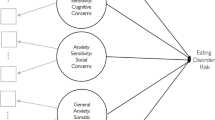ABSTRACT
Although previous research has supported the importance of anxiety as an etiological and maintenance factor for eating disorders, the specific mechanisms are not well understood. The role of anxiety in the context of eating behavior is especially unclear. The purpose of this study was to identify anxiety-eliciting eating situations and anxiety management strategies patients use to mitigate anxiety experienced in the context of eating as determined by diagnostic groups and symptom patterns. Fifty-three eating disorder outpatients were administered the Eating and Anxiety Questionnaire (EAQ) and the Eating Disorder Diagnostic Scale. Ratings indicated significant anxiety in most eating situations, whereas management strategies were more limited yet regularly employed. Factor analysis of the EAQ revealed a 6-factor solution for anxiety management strategies and a 4-factor solution for anxiety-eliciting situations. These results indicate patients with eating disorders report high levels of anxiety associated with eating behaviors but utilize limited yet consistent anxiety management strategies. Effective intervention strategies for managing eating-related anxiety should be incorporated into treatment and may need to be specified for different diagnostic subgroups.
Similar content being viewed by others
References
Fornari V, Kaplan, M, Sandberg DE, et al. Depressive and anxiety disorders in anorexia nervosa and bulimia nervosa. Int J Eat Disord 1992; 12: 21–9.
Keel PK, Klump KL, Miller KB, et al. Shared transmission of eating disorders and anxiety disorders. Int J Eat Disord 2005: 38: 99–105.
Swinbourne JM, Touyz SW. The co-morbidity of eating disorders and anxiety disorders: A review. Eur Eat Disord Rev 2007; 15: 253–74.
Godart NT, Flament MF, Lecrubier Y, et al. Anxiety disorders in anorexia nervosa and bulimia nervosa: comorbidity and chronology of appearance. Eur Psychiatry 2000; 15: 38–45.
Grucza RA, Przybeck TR, Cloninger, CR. Prevalence and correlates of binge eating disorder in a community sample. Compr Psychiatry 2007; 48: 124–31.
Pearlstein, T. Eating disorders and comorbidity. Arch Women Ment Health, 2002; 4: 67–78.
Cassin SE, von Ranson, KM. Personality and eating disorders: a decade in review. Clin Psychol Rev 2005; 25: 895–916.
Kaye WH, Bulik CM, Thornton L, et al. Comorbidity of anxiety disorders with anorexia nervosa and bulimia nervosa. Am J Psychiatry 2004; 161: 2215–21.
American Psychiatric Association. Diagnostic and statistical manual for psychiatric disorders: Fourth edition. Washington, DC, American Psychiatric Press, 1994.
World Health Organization. International statistical classification of diseases and health related problems: Tenth revision. Geneva, World Health Organization, 1992.
Fairburn CG, Cooper Z. The Eating Disorder Examination (12th Edition). In: Fairburn CG, Wilson GT (Eds) Binge eating: nature, assessment, and treatment. New York, Guildford Press, 1993, pp 317–60.
Kaye WH, Fudge JL, Paulus M. New insights into symptoms and neurocircuit function of anorexia nervosa. Nat Rev 2009; 10: 573–82.
Stice E, Telch CF, Rizvi SL. Development and validation of the eating disorder diagnostic scale: a brief self-report measure of anorexia, bulimia, and bingeeating disorder. Psychol Assess 2000; 12: 123–31.
Stice E, Fisher M, Martinez E. Eating disorder diagnostic scale: additional evidence of reliability and validity. Psychol Assess 2004; 16: 60–71.
Kaiser HF. The application of electronic computers to factor analysis. Educ Psychol Meas 1960; 20: 141–51.
Cattell RB. The scree test for the number of factors. Multivar Behav Res 1966; 1: 245–76.
Strober M, Freeman R, Morrell W. The long-term course of severe anorexia nervosa in adolescents: Survival analysis of recovery, relapse, and outcome predictors over 10–15 years in a prospective study. Int J Eat Disord 1997; 22: 339–60.
Fairburn CG, Shafran R, Cooper Z. A cognitive behavioural theory of anorexia nervosa. Behav Res Ther 1999; 37: 1–13.
Author information
Authors and Affiliations
Corresponding author
Rights and permissions
About this article
Cite this article
Webb, C.M., Thuras, P., Peterson, C.B. et al. Eating-related anxiety in individuals with eating disorders. Eating Weight Disord. 16, e236–e241 (2011). https://doi.org/10.1007/BF03327466
Received:
Accepted:
Published:
Issue Date:
DOI: https://doi.org/10.1007/BF03327466




